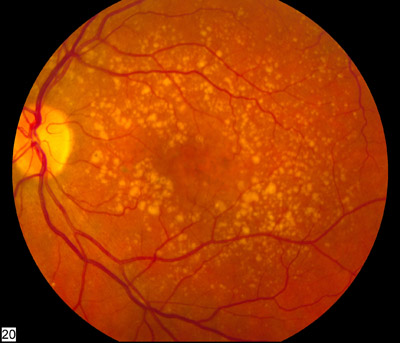How the eye prevents the destructive growth of blood vessels that would otherwise block the path of light reaching the retina has been discovered by scientists in the US.  The work might lead to new treatments for blinding disorders, like macular degeneration.
The work might lead to new treatments for blinding disorders, like macular degeneration.
There are at least two places in the body where blood vessels are actively discouraged from growing: one is the cornea, on the front of the eye; the other is the retina, the light-sensitive sheet at the back of the eye.
This vessel-suppressive effect is exerted with good reason, because if blood vessels do invade these sites, they can impair vision - and even cause blindness - by scattering light and - in the retina - triggering bleeding.
But how is this achieved? Both sites - cornea and retina - it turns out, produce a soluble molecule that soaks up - and therefore blocks - the signal that would normally trigger blood vessels to form.
The substance responsible is called sFlt and is the receptor for a blood vessel growth-promoting signal called VEGF, short for vascular endothelial growth factor, which is produced at sites where oxygen demand is high and serves to promote blood vessel in-growth.
But by releasing the sFlt receptor into their immediate environment as they do, the cornea and retina are effectively pumping out decoy molecules that can soak up the VEGF signal locally, preventing it from triggering blood vessel growth.
The breakthrough that enabled University of Utah scientist Bala Ambati and his colleagues to make the discovery, announced this week in the journal ELife, was that the Florida manatee has a cornea riddled with blood vessels and lacks this signal.
Strains of mutant mice with changes to their sFlt genes similarly have have vascularised corneas, which regresses when a working copy of the sFlt gene is supplied.
The same is also true in the retina, Ambati found, where the sFlt signal is produced by a layer called the RPE - retinal pigment epithelium, which sits above the blood vessels that supply the retina and therefore acts a chemical barrier to blood vessel in-growth.
Clinically, the result is very significant, because a major cause of sight loss in old age is a condition called wet macular degneration, where blood vessels grow abnormally into the retina leading to haemorrhages and destruction of the normal retinal architecture.
Developing ways to supplement the sFlt signal could therefore be a powerful tool in the treatment of this class of diseases.
- Previous Killing off pain
- Next Quickfire Science: Project Loon










Comments
Add a comment